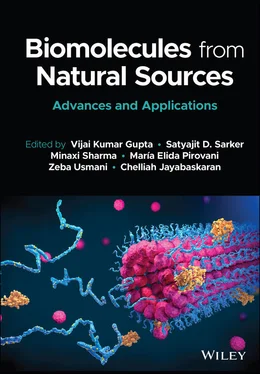Biomolecules from Natural Sources
Здесь есть возможность читать онлайн «Biomolecules from Natural Sources» — ознакомительный отрывок электронной книги совершенно бесплатно, а после прочтения отрывка купить полную версию. В некоторых случаях можно слушать аудио, скачать через торрент в формате fb2 и присутствует краткое содержание. Жанр: unrecognised, на английском языке. Описание произведения, (предисловие) а так же отзывы посетителей доступны на портале библиотеки ЛибКат.
- Название:Biomolecules from Natural Sources
- Автор:
- Жанр:
- Год:неизвестен
- ISBN:нет данных
- Рейтинг книги:5 / 5. Голосов: 1
-
Избранное:Добавить в избранное
- Отзывы:
-
Ваша оценка:
- 100
- 1
- 2
- 3
- 4
- 5
Biomolecules from Natural Sources: краткое содержание, описание и аннотация
Предлагаем к чтению аннотацию, описание, краткое содержание или предисловие (зависит от того, что написал сам автор книги «Biomolecules from Natural Sources»). Если вы не нашли необходимую информацию о книге — напишите в комментариях, мы постараемся отыскать её.
An up-to-date exploration of new and novel biomolecules Biomolecules from Natural Sources: Advances and Applications,
Biomolecules from Natural Sources: Advances and Applications
Natural Sources: Advances and Applications
Biomolecules from Natural Sources — читать онлайн ознакомительный отрывок
Ниже представлен текст книги, разбитый по страницам. Система сохранения места последней прочитанной страницы, позволяет с удобством читать онлайн бесплатно книгу «Biomolecules from Natural Sources», без необходимости каждый раз заново искать на чём Вы остановились. Поставьте закладку, и сможете в любой момент перейти на страницу, на которой закончили чтение.
Интервал:
Закладка:
18 Cappelletti, M., Presentato, A., Piacenza, E., Firrincieli, A., Turner, R.J., and Zannoni, D. (2020). Biotechnology of Rhodococcus for the production of valuable compounds. Applied Microbiology and Biotechnology 104: 8567–8594.
19 Carrillo, P.G., Mardaraz, C., Pitta-Alvarez, S.I., and Giuliett, A.M. (1996). Isolation and selection of biosurfactant producing bacteria. World Journal of Microbiology & Biotechnology 12 (1): 82–84.
20 Christova, N., Lang, S., Wray, V., Kaloyanov, K., Konstantinov, S., and Stoineva, I. (2015). Production, structural elucidation and in vitro antitumor activity of trehalose lipid biosurfactant from Nocardia farcinica strain. Journal of Microbiology and Biotechnology 25: 439–447.
21 Ciapina, E.M.P., Melo, W.C., Santa Anna, L.M.M., Santos, A.S., Freire, D.M.G., and Pereira, N. (2006). Biosurfactant production by Rhodococcus erythropolis grown on glycerol as sole carbon source. Applied Biochemistry and Biotechnology 131 (1–3): 880–886.
22 Cooper, D.G. and Goldenberg, B.G. (1987). Surface-active agents from two bacilllus species. Applied and Environmental Microbiology 53: 224–229.
23 Cortés-Sánchez, A.J., Hernández-Sánchez, H., and Jaramillo-Flores, M.E. (2013). Biological activity of glycolipids produced by microorganisms: new trends and possible therapeutic alternatives. Microbiological Research 168 (1): 22–32.
24 Crouzet, J., Arguelles-Arias, A., Dhondt-Cordelier, S., Cordelier, S., Pršić, J., Hoff, G., Mazeyrat-Gourbeyre, F., Baillieul, F., Clément, C., Ongena, M., and Dorey, S. (2020). Biosurfactants in plant protection against diseases: rhamnolipids and lipopeptides case study. Frontiers in Bioengineering and Biotechnology 8: 1–11.
25 Davis, D.A. et al. (2001). The application of foaming for recovery of surfactin from B. subtilis ATCC 21332. Enzyme Microbiology Technology 28: 346–354.
26 DeBosch, B.J., Heitmeier, M.R., Mayer, A.L., Higgins, C.B., Crowley, J.R., Kraft, T.E., Chi, M., Newberry, E.P., Chen, Z., Finck, B.N., Davidson, N.O., Yarasheski, K.E., Hruz, P.W., and Moley, K.H. (2016). Trehalose inhibits solute carrier 2A (Slc2A) proteins to induce autophagy and prevent hepatic steatosis. Science Signaling 9 (416): 1.
27 Desai, J.D. and Banat, I.M. (1997). Microbial production of surfactants and their commercial potential. Microbiology and Molecular Biology Reviews : MMBR 61 (1): 47–64.
28 Dogan, I., Pagilla, K.R., Webster, D.A., and Stark, B.C. (2006). Expression of Vitreoscilla haemoglobin in Gordonia amarae enhances biosurfactant production. Journal of Industrial Microbiology & Biotechnology 33: 693–700.
29 Dubey, K.V. et al. (2005). Adsorption–desorption process using wood–based activated carbon for recovery of biosurfactant from fermented distillery wastewater. Biotechnology Progress 21: 860–867.
30 Esders, T.W. and Light, R.J. (1972). Glucosyl and acetyItransferases involved in the biosynthesis of glycolipids from Candida bogoriensis. The Journal of Biological Chemistry 10, 247 (5): 1375–1386.
31 Espuny, M.J., Egido, S., Rodón, I., Manresa, A., and Mercadé, M.E. (1996). Nutritional requirements of a biosurfactant producing strain Rhodococcus sp 51T7. Biotechnology Letters 18 (5): 521–526.
32 Fracchia, L., Banat, J., Cavallo, J., Ceresa, M., and Banat, C.I.M. (2015). Potential therapeutic applications of microbial surface-active compounds. AIMS Bioengineering 2 (3): 144–162.
33 Franzetti, A., Gandolfi, I., Bestetti, G., Smyth, J.P.T., and Banat, I.M. (2010). Production and applications of trehalose lipid biosurfactants. European Journal of Lipid Science and Technology 112 (6): 617–627.
34 Gein, S.V., Kuyukina, M.S., Ivshina, I.B., Baeva, T.A., and Chereshnev, V.A. (2011). In vitro cytokine stimulation assay for glycolipid biosurfactant from Rhodococcus ruber: role of monocyte adhesion. Cytotechnology 63: 559–566.
35 Geys, R., Soetaert, W., and Bogaert, I.V. (2014). Biotechnological opportunities in biosurfactant production. Current Opinion in Biotechnology 30: 66–72.
36 Groves, E., Dart, A.E., Covarelli, V., and Caron, E. (2008). Molecular mechanisms of phagocytic uptake in mammalian cells. Cellular and Molecular Life Sciences 65: 1957–1976.
37 Gudiña, E.J., Rangarajan, V., Sen, R., and Rodrigues, L.R. (2013). Potential therapeutic applications of biosurfactants. Trends in Pharmacological Sciences 34 (12): 667–675.
38 Hoq, M.M., Suzutani, T., Toyoda, T., Horiike, T., Yoshida, G., and Azuma, I.M. (1997). Role of gamma delta TCR + lymphocytes in the augmented resistance of trehalose 6,6’-dimycolate-treated mice to influenza virus infection. The Journal of General Virology 78: 1597–1603.
39 Im, J.H., Nakane, T., Yanagishita, H., Ikegami, T., and Kitamoto, D. (2001). Mannosylerythritol lipid, a yeast extracellular glycolipid, shows high binding affinity towards human immunoglobulin. BMC Biotechnology 1: 5.
40 Inaba, T., Tokumoto, Y., Miyazaki, Y., Inoue, N., Maseda, H., Nakajima-Kambe, T., Uchiyama, H., and Nomura, N. (2013). Analysis of genes for succinoyl trehalose lipid production and increasing production in Rhodococcus sp. strain SD-74. Applied and Environmental Microbiology 79: 7082–7890.
41 Iqbal, S., Khalid, Z.M., and Malik, K.A. (1995). Enhanced biodegradation and emulsification of crude oil and hyperproduction of biosurfactants by a gamma ray induced mutant of Pseudomonas aeruginosa. Letters in Applied Microbiology 21: 176–179.
42 Isoda, H., Kitamoto, D., Shinmoto, H., Matsumura, M., and Nakahara, T. (1997). Microbial extracellular glycolipid induction of differentiation and inhibition of the protein kinase C activity of human promyelocytic leukemia cell line HL60. Bioscience, Biotechnology, and Biochemistry 61 (4): 609–614.
43 Isoda, H., Shinmoto, H., Matsumura, M., and Nakahara, T. (1996). Succinoyl trehalose lipid induced differentiation of human monocytoid leukemic cell line U937 into monocyte–macrophages. Cytotechnology 19: 79–88.
44 Jain, N.K. and Roy, I. (2009). Effect of trehalose on protein structure. Protein Science 18 (1): 24–36.
45 Janek, T., Krasowska, A., Czyznikowska, Z., and Łukaszewicz, M. (2018). Trehalose lipid biosurfactant reduces adhesion of microbial pathogens to polystyrene and silicone surfaces: an experimental and computational approach. Frontiers in Microbiology 9 2441
46 Kadinov, B., Nikolova, B., Tsoneva, I., Semkova, S., Kabaivanova, L., and Dimitrova, D. (2020). Trehalose lipid biosurfactant reduced cancer cell viability but did not affect the isometric contraction of rat mesenteric arteries in vitro. International Journal Bioautomation 24 (1): 79–86.
47 Kitamoto, D., Isoda, H., and Nakahara, T. (2002). Functions and potential applications of glycolipid biosurfactants. Journal of Bioscience and Bioengineering 94 (3): 187–201.
48 Koch, A.K., Käppeli, O., Fiechter, A., and Reiser, J. (1991). Hydrocarbon assimilation and biosurfactant production in Pseudomonas aeruginosa mutants. Journal of Bacteriology 173: 4212–4219.
49 Kretschmer, A., Bock, H., and Wagner, F. (1982). Chemical and physical characterization of interfacial-active lipids from Rhodococcus erythropolis grown on n-alkanes. Applied and Environmental Microbiology 44 (4): 864–870.
50 Kügler, J. H. et al. (2014). Trehalose lipid biosurfactants produced by the actinomycetes Tsukamurella spumae and T. pseudospumae. Applied Microbiology and Biotechnology 98 (21): 8905–8915.
51 Kumari, S., Sekar, K.V., Nagasathya, A., Palanivel, S., and Nambaru, S. (2010). Effective biosurfactants production by Pseudomonas aeruginosa and its efficacy on different oils. Journal of Advanced Laboratory Research in Biology 1 (1): 31–34.
52 Kundu, D., Hazra, C., and Chaudhari, A. (2016a). Biodegradation of 2,6- dinitrotoluene and plant growth promoting traits by Rhodococcus pyridinivorans NT2: identification and toxicological analysis of metabolites and proteomic insights. Biocatalysis and Agricultural Biotechnology 8: 55–65.
Читать дальшеИнтервал:
Закладка:
Похожие книги на «Biomolecules from Natural Sources»
Представляем Вашему вниманию похожие книги на «Biomolecules from Natural Sources» списком для выбора. Мы отобрали схожую по названию и смыслу литературу в надежде предоставить читателям больше вариантов отыскать новые, интересные, ещё непрочитанные произведения.
Обсуждение, отзывы о книге «Biomolecules from Natural Sources» и просто собственные мнения читателей. Оставьте ваши комментарии, напишите, что Вы думаете о произведении, его смысле или главных героях. Укажите что конкретно понравилось, а что нет, и почему Вы так считаете.


![Джеймс Купер - Пионеры, или У истоков Саскуиханны [The Pioneers, or The sources of the Susquehannah]](/books/395797/dzhejms-kuper-pionery-ili-u-istokov-saskuihanny-t-thumb.webp)









